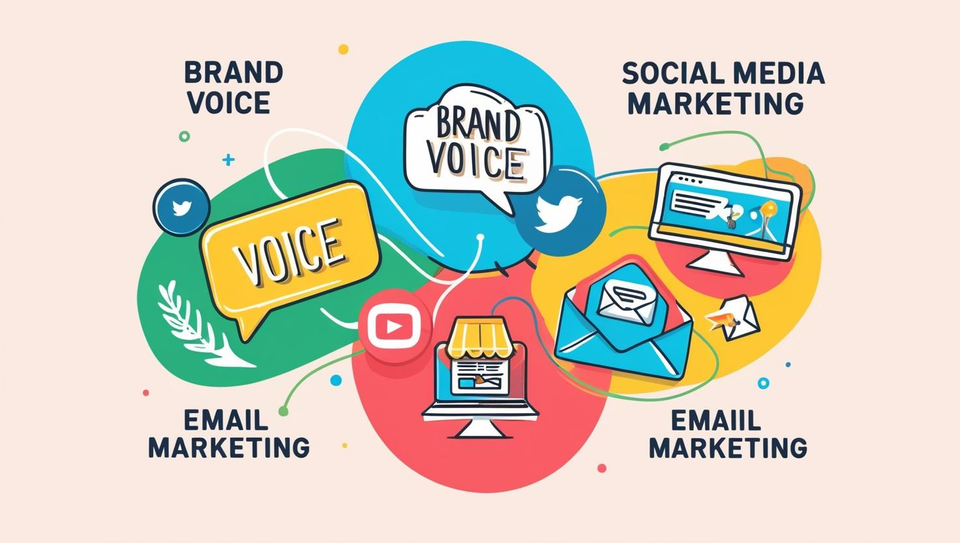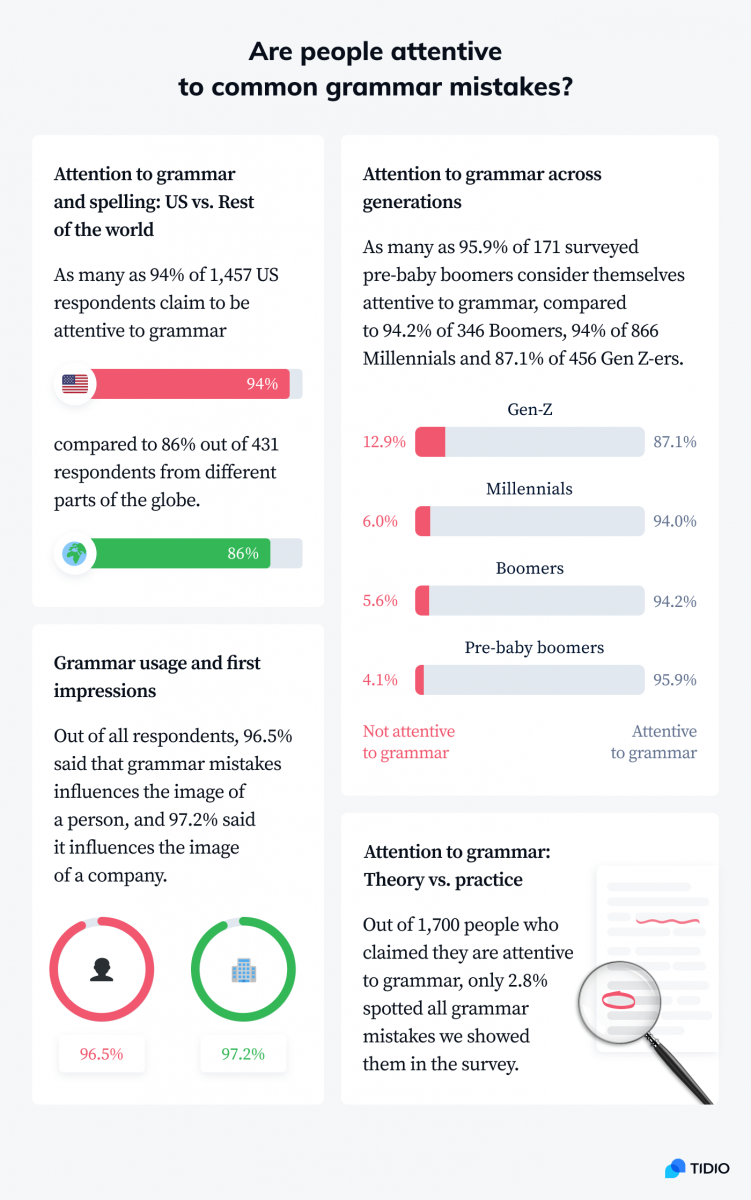Create a Brand Voice Guide in 4 Steps
Ever wonder how some brands just feel right? Their emails, their social media posts, and their website copy all sound like they come from the same person.
It’s not an accident. It’s the result of a strong, well-defined brand voice, and it’s one of the most powerful tools you have for connecting with your audience. Without a clear and consistent brand voice, your messages can become a jumbled mess, confusing your audience and weakening your brand identity.
In fact, consistent brand presentation across all platforms can increase revenue by up to 33%. That’s a massive advantage that comes from simply being consistent.
But you can’t be consistent without a plan. A brand voice guide IS that plan.
Your brand voice guidelines are your company’s rulebook for communication. They define your brand’s personality to ensure everyone who works for or represents your brand is speaking the same language.
This guide will walk you through the simple steps to create a brand voice guide of your own. You’ll learn how to define your voice, document it, and use it to build a stronger, more recognizable brand that truly connects with people.
Contents
What a Brand Voice Is (and Isn’t)

Before we start building your guide, let’s make sure we’re on the same page about what a brand voice actually is. Getting this right is the foundation for everything else.
Your brand’s voice is its personality and the unique way it communicates with the world. Without defining it, your messages can become mixed, confusing your audience and weakening your identity.
The difference between brand voice and tone

Think of it this way: Voice is your brand’s personality, while tone is its mood. Your personality (voice) stays the same, but your mood (tone) changes depending on the situation.
You have one personality, but you probably don’t speak to your boss the same way you speak to your best friend or your grandma. Your core personality doesn’t change, but your tone adapts to different situations.
It’s the same for your brand. Your brand voice should be consistent, but your tone should be flexible.
- Voice: Who your brand is at its core (helpful, witty, inspiring).
- Tone: How your brand expresses its voice in a specific context (e.g., using an encouraging tone in a tutorial video or a more serious tone when addressing a customer complaint).
40% of consumers want memorable content from brands, and 33% want a brand with a distinct personality. You can’t achieve either of those without first understanding the difference between your core personality (voice) and its situational expression (tone).
A brand voice is more than just a list of words
While your guide will include preferred words and phrases, your brand voice is so much bigger than a vocabulary list. It’s the underlying feeling you create. It’s the rhythm of your sentences, your use of punctuation, and the emotions you evoke.
Consumers who feel an emotional connection to a brand have a 306% higher lifetime value and are 71% more likely to recommend the company. Your voice is the primary tool for building that emotional connection.
Common mistakes
It’s easy to get style guides, brand voice, and mission statements mixed up because they are all part of your larger brand identity. But they serve very different functions. Here’s a simple breakdown:
| Document | Purpose | Answers the Question… |
|---|---|---|
| Brand Voice Guide | Defines your brand’s communication personality. | How do we sound? |
| Visual Style Guide | Defines your brand’s look and feel. | How do we look? |
| Mission Statement | Defines your brand’s core purpose and goals. | Why do we exist? |
All three need to work together, but your brand voice guide is specifically focused on the words you use to bring your brand to life.
Why Your Business Needs a Brand Voice Guide

Okay, now you understand what a brand voice is. But is creating a whole guide for it really worth the time and effort?
Absolutely. A brand voice guide isn’t just a “nice-to-have” document for your marketing team. It’s a critical business tool that impacts everything from customer trust to your bottom line.
How a guide builds consistency across all channels
Your customers interact with you in dozens of places: your website, social media, email newsletters, chatbots, and paid ads. A brand voice guide is the single source of truth that ensures the experience is seamless everywhere.
This consistency is what separates the amateurs from the professionals.
Maintaining brand consistency across all platforms can significantly increase revenue, so a unified message is not just good for branding but also for business growth. When your voice is consistent, your brand feels more stable and reliable.
Consistency builds trust and recognition

Humans are wired to trust what is familiar and predictable. When your brand consistently sounds the same, your audience learns what to expect. This familiarity builds trust over time.
Think about it: if a friend acted cheerful and bubbly one day, then cold and formal the next, you’d feel confused and unsure of them. The same is true for a brand.
The Edelman Trust Barometer emphasizes that consumers are more likely to trust and buy from brands that are reliable and authentic—qualities that are impossible to convey with an inconsistent voice. A consistent voice shows that your brand is dependable.
How it helps freelancers and new hires
How much time do you spend editing content from a new employee or a freelance writer to make it “sound right”? A brand voice guide practically eliminates this guesswork.
It’s an essential onboarding tool that helps new team members understand your brand’s personality from day one. It empowers your entire team to create content with confidence and reduces the time managers spend on revisions. This efficiency is a huge, often overlooked, benefit. Instead of constantly correcting people, you empower them to get it right from the start.
A strong voice makes your brand more memorable
In a crowded market, a distinct personality helps you stand out. A great case study for this is the language-learning app Duolingo.

Duolingo’s voice is famously unhinged in a playful way. Its social media presence, led by its mascot Duo the owl, is quirky, persistent, and hilarious. The brand’s TikTok is full of videos of Duo causing mischief and chasing users to do their daily lessons. This unique and consistently applied voice has made the brand a viral sensation, especially with younger audiences.
It’s memorable because it’s so different from the typically dry and educational tone of other learning apps. An analysis of their strategy shows their “entertainment-first” approach to content has been key to their massive organic reach and brand recognition.
Gather Your Core Brand Info
Ready to get practical? The first phase of creating your brand voice guide is all about gathering information. You need to look inward at your company’s foundation to define a voice that is authentic and true to who you are.
Start with your company’s mission statement
%3Amax_bytes(150000)%3Astrip_icc()%2Fmission-statement-4192827-final-6acb0b8f71364973b36e441be258ae6d.jpg&f=1&nofb=1&ipt=e53ba00806b5f0f39a8dd94e5dd33a89f17f7b7112a60b683f0362b3a7396dc6)
Your mission statement is your “why.” It’s the reason your company exists beyond making money. Your brand voice should be a direct reflection of this mission:
- If your mission is to “make technology accessible to everyone,” your voice should be simple, clear, and encouraging.
- If your mission is to “challenge the status quo,” your voice might be bold, direct, and provocative.
Consumers are 4x to 6x more likely to purchase from, trust, and defend companies with a strong, clear purpose. Your mission is that purpose, and your voice is how you express it. Start here to ensure your voice has substance.
Review your brand values
Your values are the principles that guide your brand’s behavior. Are you honest, innovative, sustainable, or community-focused? These values should be woven into every word you write.

A perfect example is the outdoor apparel company Patagonia. One of their core values is environmentalism. Their communication is often brutally honest, educational, and focused on activism.
Their famous “Don’t Buy This Jacket” ad campaign was a direct expression of their value of sustainability. By living their values so publicly, their voice has become one of the most trusted and authentic in any industry.
Describe your target audience or customer persona
You can’t have a conversation without knowing who you’re talking to. Take time to clearly define your target audience. Go beyond basic demographics and think about their psychographics:
- What are their goals and motivations?
- What are their pain points?
- What kind of humor do they appreciate?
- What other brands do they love?

The more deeply you understand them, the better you can tailor your voice to resonate with them. 71% of consumers expect companies to deliver personalized interactions, and 76% get frustrated when this doesn’t happen.
Speaking in a voice that understands and reflects your audience’s world is a key form of personalization.
Use examples of existing content
Go on a treasure hunt through your own marketing materials. Look at past blog posts, emails, social media updates, and ad copy. Find the pieces that you feel “just work.”
Create a folder and save screenshots or links to these examples. For each one, ask yourself: What makes this so good? Is it the word choice? The humor? The sentence structure?
This exercise will help you identify the natural voice that may already exist within your brand, giving you a tangible starting point.
Define Your Brand’s Personality in 4 Steps
Now for the creative part. With your foundational information gathered, it’s time to translate it into a distinct personality. This is where you move from abstract ideas like “values” to a concrete communication style.
Step 1: Brainstorm 3 to 5 adjectives

If your brand was a person, how would you describe them? Try to use personality traits for adjectives when describing how a company should sound.
Make a list of 3 to 5 core adjectives that are also personality traits. (This exercise is about making choices. You can’t be everything to everyone.) Here are some example adjectives to get you started:
- Passionate
- Witty
- Authoritative
- Playful
- Caring
- Formal
- Irreverent
- Sophisticated
This approach is rooted in the “Brand Personality Dimensions” framework, which organizes brand traits into five core dimensions (Sincerity, Excitement, Competence, Sophistication, and Ruggedness).
Choosing a few key traits gives your brand a clear and consistent character that consumers can recognize. These adjectives will become the pillars of your brand voice.
Step 2: Use a “This, not that” chart

This is one of the most effective tools for refining your voice. For each adjective you chose, add more context by defining what it is not. This helps clarify nuance and sets clear boundaries for your writers.
Here’s an example for a fictional tech support brand:
| We Are… | We Are Not… |
|---|---|
| Helpful | Patronizing |
| Expert | Arrogant |
| Friendly | Overly familiar or silly |
| Direct | Abrupt or cold |
This chart is incredibly useful for course-correcting. If a piece of content feels “off,” you can check it against the “We Are Not” column to see where it went wrong.
Step 3: If your brand was a person, describe them

This is a fun exercise that solidifies the concept: take your adjectives and your “trhis, not that” chart and write a short paragraph describing your brand as a person. This is often where brand archetypes can be useful.
Archetypes are universally recognized characters that can help provide a shorthand for your brand’s personality (The Hero, The Sage, The Jester).
For example, Nike is the classic Hero archetype, focused on mastery and overcoming challenges. Their voice is inspirational, competitive, and empowering. Google is The Sage, focused on knowledge and truth. Their voice is helpful, knowledgeable, and clear.
Choosing an archetype can give you a well-established framework to build upon, ensuring your brand’s personality feels both unique and familiar. Branding agencies still rely heavily on this framework to quickly establish a brand’s core identity.
Step 4: Use simple analogies
Imagine your brand is a person at a party. What kind of person is it?
- Is it the friendly, approachable host making sure everyone feels welcome? That might be a brand like Zappos.
- Or is it the witty intellectual in the corner sharing fascinating facts? That could be a brand like The New Yorker.
- Is it the energetic life of the party telling hilarious stories? You might be thinking of a brand like Old Spice.
This “person” is your brand voice. It doesn’t matter if they’re talking to one person or a group, their personality remains the same.
Build the Sections of Your Guide
You have the ingredients. Now, let’s structure your cookbook. A good brand voice guide is well-organized, easy to scan, and full of practical examples. Here are the essential sections to include.
Brand character
This is the introduction to your guide. It’s a high-level summary of your brand’s personality. This section should include:
- Your list of 3 to 5 brand voice adjectives
- Your “We Are This, We Are Not That” chart
- A short paragraph describing your brand as a person
- A few analogies illustrating the brand’s “role”
It’s the first thing someone reads, giving them an immediate feel for your brand’s voice.
Tone of voice

Here, you’ll show how your voice adapts to different situations. You don’t need to cover every possible scenario, but you should outline the most common ones. For each situation, provide a short description of the tone and a “before and after” example.
For example:
- Situation: A customer is frustrated with a product bug.
- Tone: Empathetic, clear, and reassuring.
- Example:
- Before (wrong tone): “Your ticket has been received. We will investigate the issue.”
- After (correct tone): “I’m so sorry you’re running into this bug—that sounds incredibly frustrating. I’ve passed all of your details to our engineering team, and we’ll get back to you with an update within 24 hours.”
Vocabulary and phrasing
This is where you get specific about the words you use. Create simple lists that are easy to reference.
- Words we use:** (“team,” “folks,” “clients,” “customers”).
- Words we avoid:** (“users,” “synergy,” “utilize,” “ninja”).
- Company and Product Names:** How do you write your company name? Is it “MyCompany” or “My Company”? Be specific.
This section removes ambiguity and helps maintain consistency down to the smallest detail.
Grammar and punctuation
This might seem tedious, but it makes a huge difference in how professional your brand appears. 97% of readers consider brands with poor grammar and spelling as less credible. Your guide should provide clear rules on your most common style choices.

Do you use:
- the Oxford comma? (“red, white, and blue”)
- title case or sentence case for headlines?
- contractions (“you’re,” “it’s”)?
- numbers as numerals (10) or words (ten)?
You don’t need to write a full grammar textbook. Just document your top 5 to 10 rules.
Put Your Brand Voice Guide to Work
A guide sitting on a server is useless. A great brand voice guide is a living document that you should actively use and integrate into your company culture. Here’s how to make that happen.
Store the guide in an easily accessible place

Don’t bury your guide in a complex folder system. It should be one click away for anyone who creates content. Store it in a central, cloud-based location that your whole team can access, like:
- A pinned page in your company’s Notion or Slack.
- A shared Google Doc with a memorable URL.
- Your company’s internal wiki or intranet.
The key is to make it frictionless for you and those you hire to find and use.
Introduce the guide to others
Don’t just email the guide and hope people read it. Launch it! Hold a short workshop or a “lunch and learn” session to walk your team through the document and how to use it.
Make it engaging. Explain why you created it, walk through the key sections, and do a few fun exercises. You could have your team try rewriting a few sentences to match the new voice. This gets them involved and helps them understand the principles in a practical way.
Share tips on using the guide to review content

The guide should become part of your content creation workflow. One effective way to do this is to create a simple editing checklist based on the guide.
Before publishing any piece of content, the creator (or an editor) can run through the checklist:
- Does this reflect our 3 core adjectives?
- Does it align with our “This, Not That” chart?
- Is the tone appropriate for the context?
- Does it use our preferred vocabulary?
- Does it follow our grammar rules?
This turns the guide from a static document into an active quality control tool.
Revisit your brand voice guide periodically
A brand voice guide isn’t something that you set and forget.
Your brand isn’t static, and your brand voice guide shouldn’t be either. As your company grows, your mission evolves, and your audience changes, you may need to tweak it.
Plan to review your brand voice guide at least once a year. See what’s working, what’s not, and what might be outdated. This follows agile marketing principles, where continuous iteration leads to better results over time.
According to the Content Marketing Institute, successful content marketers are much more likely to have a documented strategy and review it regularly to adapt to new challenges and opportunities. Treat your guide the same way–as a living document.
Wrap Up
Creating a brand voice guide isn’t just an exercise—it’s one of the most important steps you can take to build a powerful and consistent brand identity. By defining your character, choosing your words with intention, and setting clear communication guidelines, you empower your team and/or those you hire to speak with one, authentic voice.
This clarity and consistency will do more than just make your content better. It will build deep, lasting trust with your audience, make your brand instantly recognizable, and create a stronger connection with the people you want to serve. Use this plan to start building your guide today and watch your brand communication become clearer and more effective than ever before.
References
12 Brand Archetypes and How to Know Which to Use for Your Business. (2025). No Boring Design. Retrieved from https://www.noboringdesign.com/blog/12-brand-archetypes
Aaker, J. L. (1997). Dimensions of Brand Personality. Journal of Marketing Research, 34(3), 347–356. https://doi.org/10.2307/3151897
Arora, N., Ensslen, D., Fiedler, L., Liu, W. W., Robinson, K., Stein, E., & Schüler, G. (2021). The value of getting personalization right—or wrong—is multiplying. McKinsey & Company. Retrieved from
https://www.mckinsey.com/capabilities/growth-marketing-and-sales/our-insights/the-value-of-getting-personalization-right-or-wrong-is-multiplying
Brand Consistency: Why It’s Important and How to Achieve It. (n.d.) Marq. Retrieved from https://www.marq.com/blog/brand-consistency
Edelman. (2025). 2025 Edelman Trust Barometer. Retrieved from https://www.edelman.com/trust/2025/trust-barometer
Honigman, B. (2022). How Duolingo built a successful $250 million brand by being kind of a jerk. Fast Company. Retrieved from https://www.fastcompany.com/90741819/how-duolingo-built-a-250-million-brand-by-being-kind-of-a-jerk
Joshua. 25 Emotional Marketing Statistics – Key Facts + Case Study. (2025). eComBusinessHub.com. Retrieved from https://ecombusinesshub.com/emotional-marketing-statistics/
Meester, A. (2024). Competing On More Than Price: How Branding Can Build Revenue. Retrieved from https://www.forbes.com/councils/forbesbusinesscouncil/2024/05/09/competing-on-more-than-price-how-branding-can-build-revenue/
Our Core Values. (2022). Patagonia. Retrieved from https://www.patagonia.com/core-values/
Szaniawska-Schiavo, G. (2024). Grammar Drama: These Common Grammar Mistakes Make You’re* (sic) Company Look Dumb. Tidio. Retrieved from https://www.tidio.com/blog/common-grammar-mistakes/
Stahl, S. (2024). B2B Content Marketing Benchmarks, Budgets, and Trends: Outlook for 2025 [Research]. Retrieved from https://contentmarketinginstitute.com/b2b-research/b2b-content-marketing-trends-research
The 2025 Sprout Social Index: Edition XX. (2025). Sprout Social. Retrieved from https://sproutsocial.com/insights/index/
Unveiling the 2020 Zeno Strength of Purpose Study. (2020). Zeno Group. Retrieved from https://www.zenogroup.com/insights/2020-zeno-strength-purpose
voice. (n.d.). Duolingo Design. Retrieved from https://design.duolingo.com/writing/voice
Content Marketing Copywriting UX
